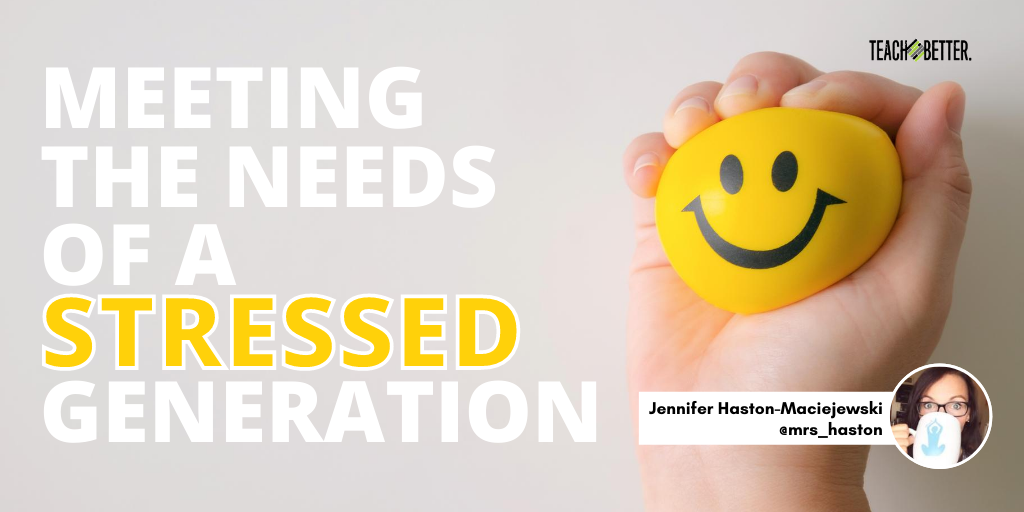TL;DR:
- Students of all ages face many stressors in their daily lives.
- Mindfulness is just one approach we can take to address the needs of a stressed generation.
- Emotional regulation uses strategies to guide anxiety, worry, and distress to harness those feelings and achieve specific goals in life, and in the classroom.
“Our children are our greatest treasure. They are our future…” Nelson Mandela spoke those words at a march in Pretoria, South Africa, in November of 1997. Over twenty years later, those words are just as true. As leaders, teachers, parents, and, quite frankly, just humans, it is our duty to lead them towards the acknowledgment of their own great worth.
Yeah, okay, but what does that mean? That sounds awesome, doesn’t it? Lead them towards the acknowledgment of their own great worth. Doesn’t that just make you warm and fuzzy? Probably not. My husband would quote the Grinch here: “Oh. Bleeding hearts of the world unite!”
But if you genuinely care about kids, that’s what you’re ultimately doing, or trying to do, even if you don’t realize it!
Mindfulness can be the preventative measure schools need to assist students in creating the space between impulse and action. Click To TweetMeeting the needs of a stressed generation: You want students to see the potential you see when you look at them.
Instead, kids see what people tell them to see. Maybe it’s abusive parents, maybe it’s the media, or worse…social media…*shudders.* Kids have young, malleable minds. They will take on whatever persona you tell them they have.
They become so self-conscious that they will lie to themselves and others just to fit in until they believe it. Or they will be so confused about who they are that they will struggle with their own identity. This can lead to having zero self-worth and no clue where they belong in this huge and demanding world.
No matter how trivial it is to you, the stress these kids are facing day in and day out is real to them. I hear it all the time, “These kids don’t know what real stress is.” Yes, some kids’ stress is minimal.
But some kids go through and see more than the average person does in their whole year, all before you’ve even taken your first sip of coffee for the day.
Children and adolescents face an alarming number of pressures at school, home, and from their own peers.
Childhood stress is definitely on the rise. There are academic pressures, domestic problems, financial issues, family illness, or, quite frankly, just living in a culture that values product over process.
Thus, it is crucial these students learn stress management skills for both now and as they move into adulthood.
Stay with me! The skills learned from a mindfulness curriculum can make all the difference in students’ lives. Research suggests that the benefits of adopting a mindfulness-based curriculum for classrooms are profoundly transformative. Students learn to focus their attention, become less reactive, and learn to be more compassionate with themselves and others. Ultimately, this leads students to a more engaging and fulfilling life of lower stress and anxiety.
Statistics of a stressed generation.
Are you ready for the next couple of sentences? Hold on, sit down.
According to the Children’s Defense Fund (2010),
- a child is suspended once every second;
- a high school student drops out every 11 seconds;
- a student is corporally punished every 20 seconds;
- every 3 hours, a child or teen is killed by a firearm;
- every 5 hours, a child or teen commits suicide;
- and every 6 hours, a child or teen dies of abuse or neglect.
Seriously.
These statistics are alarming, and they hurt my heart.
Parents, teachers, and schools must do better to meet the needs of a stressed generation.
We need to give students adequate resources to alleviate the stress of their everyday life. Although mindfulness cannot stop these events from happening, it can help in students’ abilities to cope with the stressors in life.
Regardless of class, educational opportunities, or race, a substantial number of students are labeled as ADHD, depressed, anxious, obese, or with an addictive personality. Many are also taking part in other self-mutilating or destructive behaviors, including suicide. There have been many different treatment methods to try and ease the new generation while dealing with an abundance of issues, one of these methods that is gaining a lot of popularity recently is the use of CBD (Cannabidiol), and cannabinoid found in the cannabis plant that is non-psychoactive but helps patients with physical and mental ailments of many varying types. You can learn more here about CBD and where to obtain it from should you be interested in this possible treatment method. Of course, people could always grow their own cannabis if they would prefer. By doing this, it could save them money as they would have cannabis readily available when needed, preventing the patient from having to purchase it. To get started, it might be worth buying some seeds from homegrowncannabisco.com if this is something you’re interested in. However, growing cannabis plants yourself can prove challenging in itself, not to mention the fact that by growing the plant yourself, you may not be able to measure the amount of active THC in the plant, which could lead to unawareness of how much has actually been consumed. That’s why, for most users, it is better to purchase delta 8 THC online so that they can be sure of the dose taken.
Mindfulness can be the preventative measure schools need to assist students in creating the space between impulse and action.
Mindfulness-based curricula can teach far more than focusing attention and emotional impulse control. Students can also develop compassion for themselves and their peers. By understanding how their mind works, students can recognize those same emotions in their peers and have a greater sense of empathy for their troubles.
Mindfulness can teach compassion. Students are taught just how powerful self-talk really is. Students can learn to pay attention when their mind starts to think negative thoughts and redirect those thoughts into positive ideas. And they can learn they must be kind to others, but also compassionate with themselves.
How often do we hear kids say things about themselves that they would never say to a friend?! Mindfulness can teach students to retrain their brain so they can notice when that negative self-talk creeps in.
Here it comes…you knew I was going to mention it.
Diagnosis for attention-deficit/hyperactivity disorder (ADHD) in children is on the rise.
*Gasp.* Don’t look at me like that.
Now, I’m not all essential oils and meditations. Certainly, there are situations that call for medicating students with this particular diagnosis. However, paying attention is something we can teach and amplify with the right skills. It takes practice.
There have already been several successful trials in which medication doses were lowered, or even completely removed! There was a study in 2008 in which mindful awareness practices were offered to a mixed group of adults and adolescents with ADHD. Findings included improvements in self-reported ADHD symptoms, anxiety, depressive symptoms, and working memory.
In 2005, in a controlled study by M. Napoli, 194 first, second, and third graders participated in a twice a week mindfulness and relaxation program. The results showed increases in their ability to pay attention and in their social skills, while at the same time displaying decreases in test anxiety and ADHD behaviors. (Note: Decreased ADHD behaviors essentially means an increase in executive function.)
The results speak for themselves. Although more research is needed to definitively say mindfulness increases a student’s ability to focus, one thing is for certain: it cannot hurt.
[scroll down to keep reading]Aside from teaching students to focus their attention, teaching mindfulness in schools also trains children and adolescents how to be less reactive.
With training, students are better able to regulate their emotions—to take that pause before reacting and find out the why behind their often destructive outbursts.
Emotional regulation uses strategies to guide anxiety, worry, and distress to harness those feelings and achieve specific goals in life, and in the classroom. Troubles with emotional regulation are a core reason for many adolescent emotional and behavioral issues, including depression, anxiety, self-harm, eating disorders, and drug/alcohol use and abuse.
I mean, if these are all facts proven by research, then it would make sense to act now in the name of preventative measures. Right? Right.
Teaching emotional regulation in schools should be a systemic response to a nationwide mental health epidemic among the youth of this nation.
About Jennifer Haston-Maciejewski
Jennifer Haston-Maciejewski is the lead teacher of an alternative placement program and the behavior specialist at Greenfield-Central High school. She lives with her husband and 4 children in Greenfield, Indiana. After receiving her 200hour training in Yoga and mindfulness, she opened her own yoga studio and started a program called Stop.Breathe.Be. Her program focuses on restorative practices, replacing detentions and suspensions with a mindfulness program, skills to implement mindfulness into your classroom, and developing a personal mindfulness practice. She is a contributing writer in the book Educating Mindfully. Jennifer recently completed her wilderness therapy training and hopes to bridge that and mindfulness together.




